�
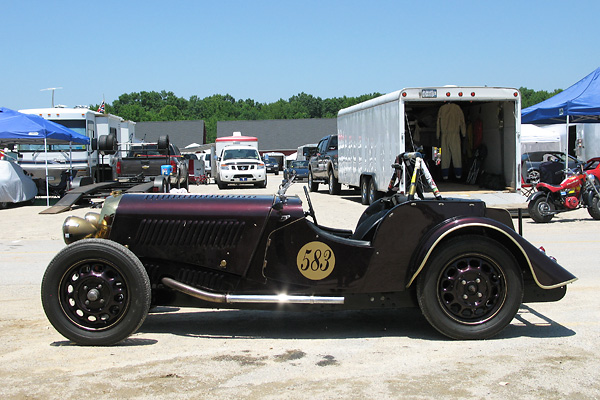
�
Carlton Shriver's Morgan 4-4 Race Car, Number 583
� � Owner: Carlton Shriver� City: Sharpsburg, Maryland
� Model: 1938 Morgan 4-4 (Series 1)
� Engine: Coventry Climax 1122cc four cylinder �
�
Pre-War Morgan Motor Company History
��
The Morgan Motor Company began producing three-wheeled sporty automobiles�
in 1910. They were one of the most successful companies in this niche, and�
they broadened their market by offering new models even as competitors �
dropped like flies. Morgan three wheelers were available with four-seater �
and delivery van bodies as well as the more familiar two-seater Runabout, �
Grand Prix, Aero, Super Aero and Super Sport variants which proved �
phenomenally successful in sporting competition. Morgan utilized a wide �
variety of engines in its three-wheelers (at least 13 makes!) including �
mostly J.A.P. and Matchless V-twin engines mounted right up front. In the �
more-pragmatic 1930's, many Morgan three-wheelers were instead built with �
Ford inline four-cylinder engines mounted behind radiators. �
�
Three-wheelers were inexpensive and fun. In the early decades of automobile �
production, they were often seen as an affordable "first car". Through their �
heyday, many three-wheelers qualified as "cyclecars" and were taxed in �
England at the same rate as motorcycles, and at a lower rate than �
four-wheelers. Even after that loophole closed, three-wheelers could �
effectively utilize small horsepower engines which were taxed at a lower rate. �
These economic advantages helped, but as the public increasingly favored heavier �
cars, small manufacturers like Morgan couldn't realize "economies of scale" �
to stay price competitive. Britain's larger car companies kept lowering the �
limbo bar. The Austin "Seven" is widely credited with killing the cyclecar �
market. Not only was the Austin Seven cheap, but it came with a reverse gear! �
Morgan adapted and survived better than most. (They figured out how to add �
a reverse gear.) Still, it must have been a shocking blow when Morris slashed �
the price of their "Minor" model to just £100 in 1931. To survive, Morgan �
would have to move upmarket to compete against larger, heavier, more powerful, �
and more expensive sports cars like the M.G. Midgets.�
�
�
Enjoying this article? www.BritishRaceCar.com is partially funded through generous support from readers like you!
�
To contribute to our operating budget, please click here and follow the instructions.
�
(Suggested contribution is twenty bucks per year. Feel free to give more!)�
� Morgan survived by evolving. In December 1935 they introduced their first � production four-wheeled sports car. The "4-4" model designation denoted that � the new model featured both four wheels and a four cylinder engine. At first � glance, from the steering wheel forward the new design appeared to share much � with the Morgan F2 and F4 three-wheelers. (The F2 and F4 were Ford-engined � models, with two and four seats respectively.) However, from the very first 4-4 � prototype it was evident that the Ford 993cc engine wouldn't be sufficient for� the heavier 4-4 model. Morgan chose instead to use a Coventry Climax 1122cc � engine, which gave the 4-4 about 34 brake horsepower to propel its 1232 pound � dry weight. Just for the sake of comparison: a 1936 M.G. TA weighed 1765 � pounds and came with a 1292cc engine which produced about 50 horsepower. �
��
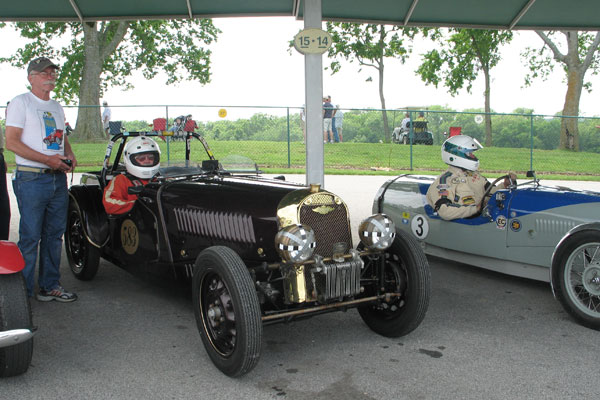
�
Carlton Shriver in his Morgan 4-4 prepares to race Bob Wilson and his 1935 Morgan F2 trike.
�
�
Production of the 4-4 would continue until World War II. When production �
resumed after the war, the model name changed to "4/4".There are few �
feature and specification differences between cars built immediately before�
and after the war. The wire mesh radiator grille was standard until late 1938, �
and remained available as optional equipment until the war (i.e. late 1939). �
A vertically slatted flat radiator grille would remain in production until 1951, �
when it was replaced with a curved "waterfall" grille. A smaller but more �
powerful competition-tuned Coventry Climax 1098cc engine was available from �
March 1939, and a Standard Special 1267cc engine was available from July 1939.�
�
 �
�
�
�
Features and Specifications
�| Engine: | �Coventry Climax four cylinder inline engine with 1122cc �
displacement (63mm bore by 90mm stroke.) Iron block and�
cylinder head, featuring overhead inlet valve and side�
exhaust valve. | �
| Cooling: | �an Aquaplane oil cooler has been added for racing. | �
| Transmission: | �Meadows four speed manual gearbox. Borg and Beck single dry plate clutch. | �
| Rear Axle: | �live axle featuring spiral bevel gears in a pressed steel banjo-style case. | �
| Front Susp.: | �sliding stub axle assemblies on vertical pillars.�
Coil springs. �
Telescoping shock absorbers. | �
| Rear Susp.: | �half-elliptic leaf springs measuring 40" between centers. �
Andre-Hartford friction shock absorbers. | �
| Brakes: | �Girling 8" drum brakes. Parking brake actuated by rods and cables. | �
| Wheels/Tires: | �Dunlop pressed steel disc wheels, mounted on four lugs each.�
Dunlop 17x4.5 tires. | �
| Dimensions: | �140" length, 54" width, 92" wheelbase, 45" track. | �
| Weight: | �1232lb dry / 1512lb wet. | �
Front Suspension
��
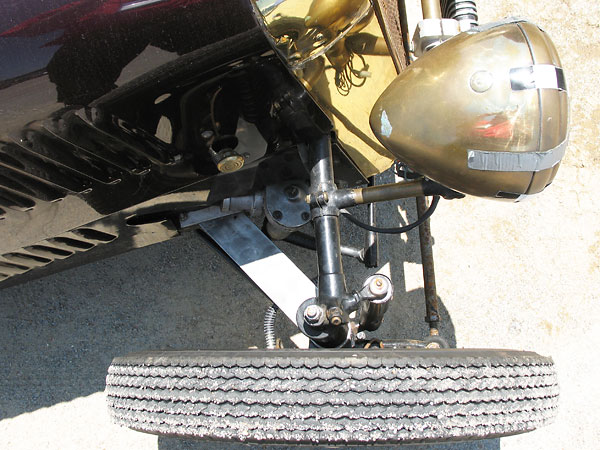
�
Sliding pillar independent front suspension.
�
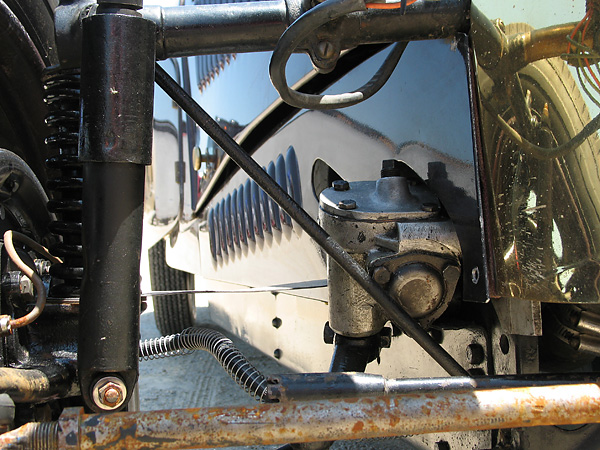
�
Actually, it's the stub axles that slide up and down on vertical pillars. Coil springs are mounted concentric
�
to the pillars, above and below the stub axles. Telescopic, hydraulic shock absorbers are mounted in front.
�
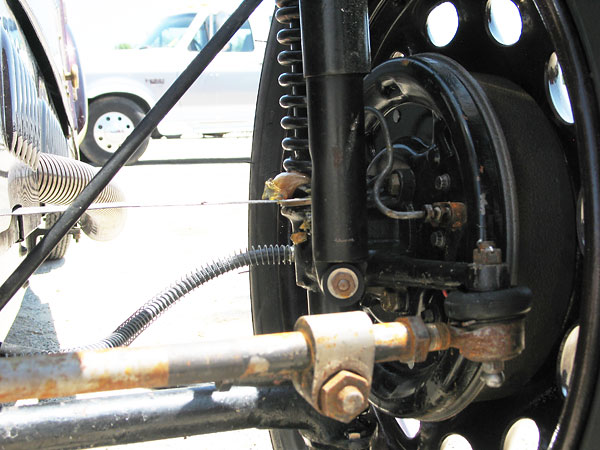
�
With sliding pillar suspensions there's no camber change as the body moves up and down on bumps,
�
the suspension's roll center is at ground level, and wheel camber is equal to body roll. Binding in
�
the suspension can be a problem on turns, plus bump and roll steer issues are inevitable.
�
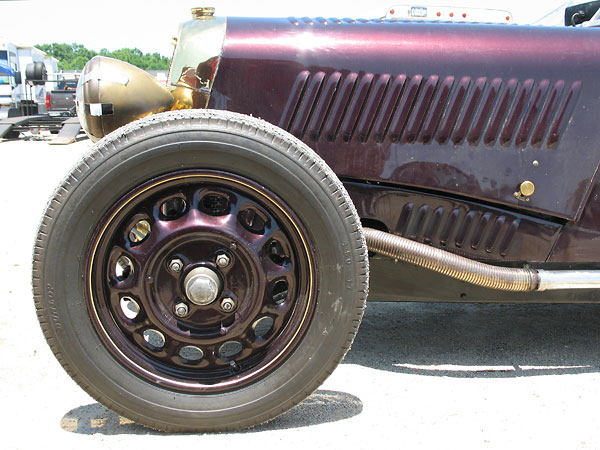
�
In contrast to their front suspension, Morgan's use of Dunlop disc wheels as standard equipment
�
(mounted on four lugs each) was more modern than many other pre-war British sports cars.
�
�
Rear Suspension
��
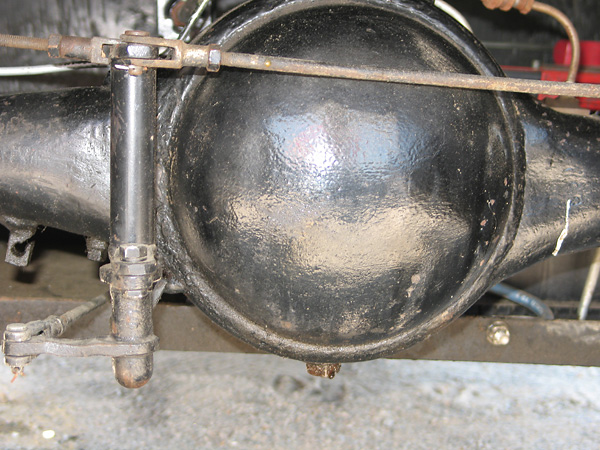
�
The parking brake is actuated via a system of rods and levers.
�
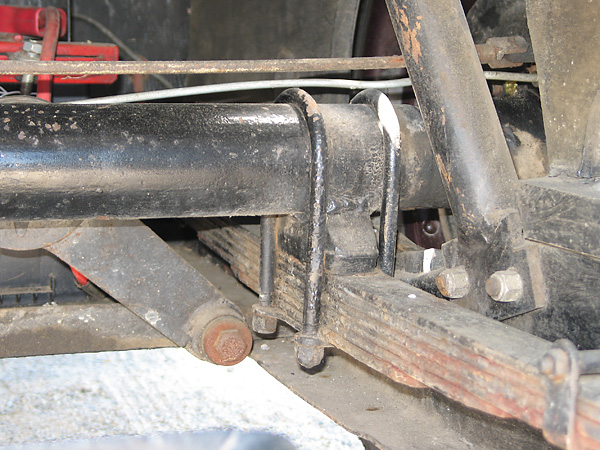
�
Notice that Morgan framerails feature an unusual Z profile; the upper flanges face outwards. The
�
rear axle is mounted above the frame, with friction shock absorbers and inboard-mounted leaf springs.
�
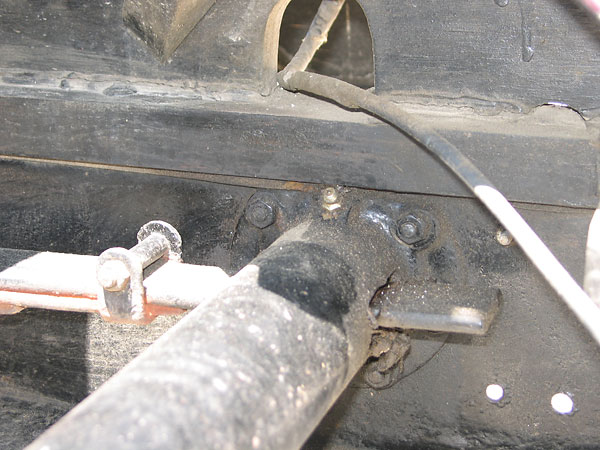
�
Instead of pivoting spring shackles at the rear, the springs slide within slots in the rear crossmember.
�
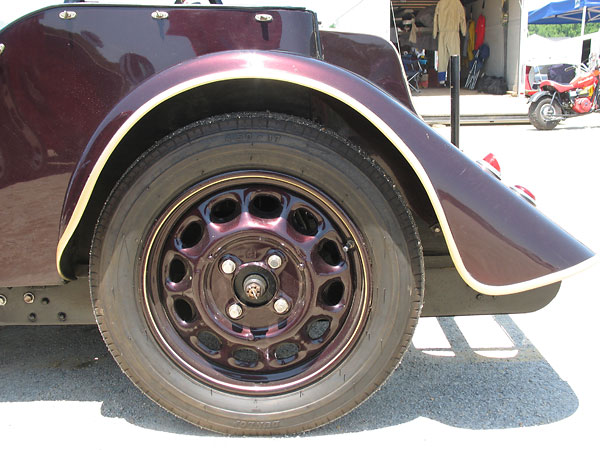
�
Dunlop 17x4.5 tires. Later Morgan 4-4's would get 16x5 tires.
�
�
Interior
��
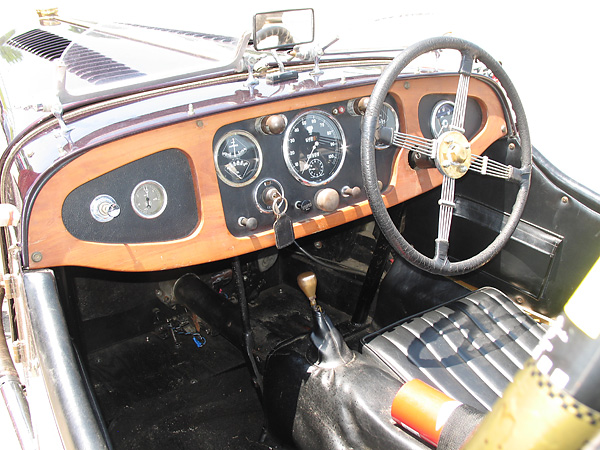
�
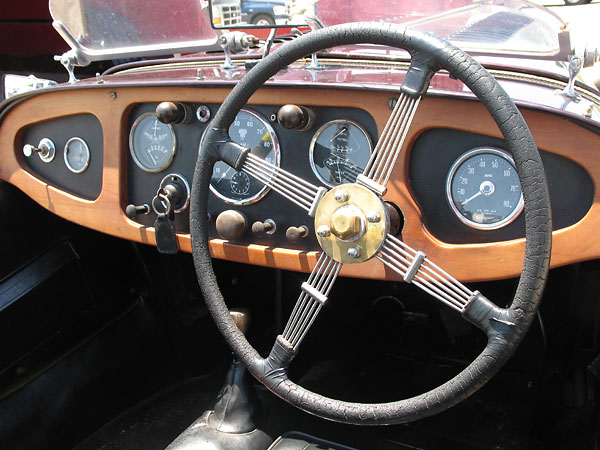
�
All 4-4's came with the "Brooklands" steering wheel as shown here, and black-faced
�
gauges. The horn button is centered in the dashboard below the speedometer.�
�
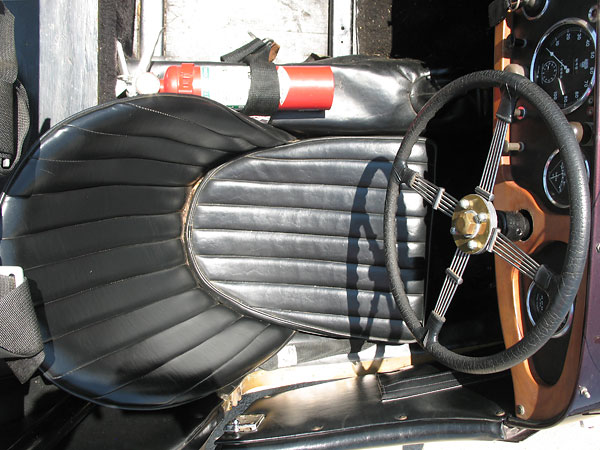
�
�
Exterior
��
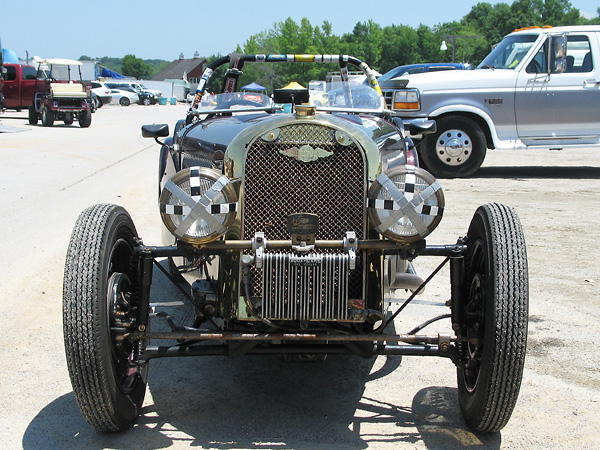
�
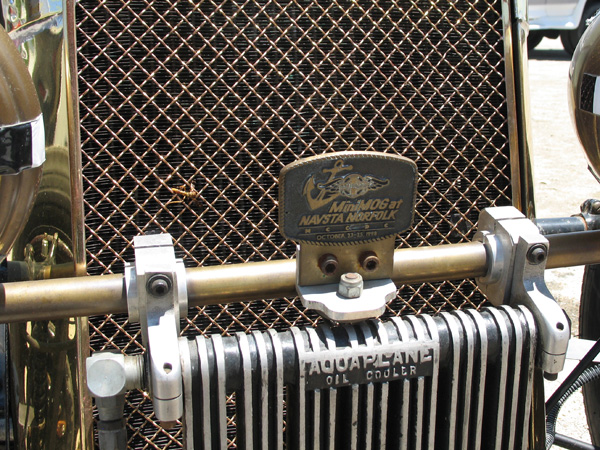
�
A stylish fifties-style Aquaplane oil cooler has been added for racing.
�
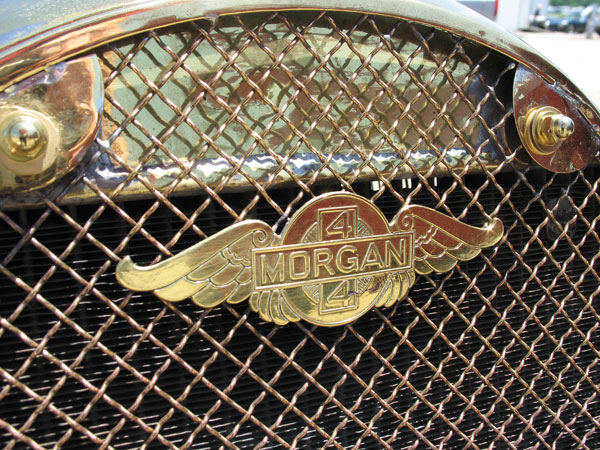
�
The wire mesh radiator grille was standard until late 1938, but available as optional equipment until WWII.
�
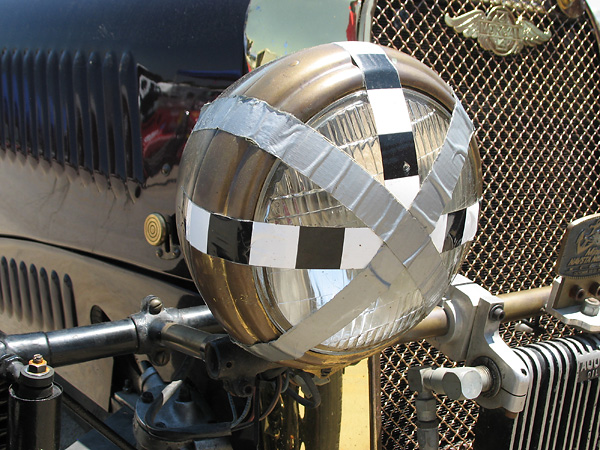
�
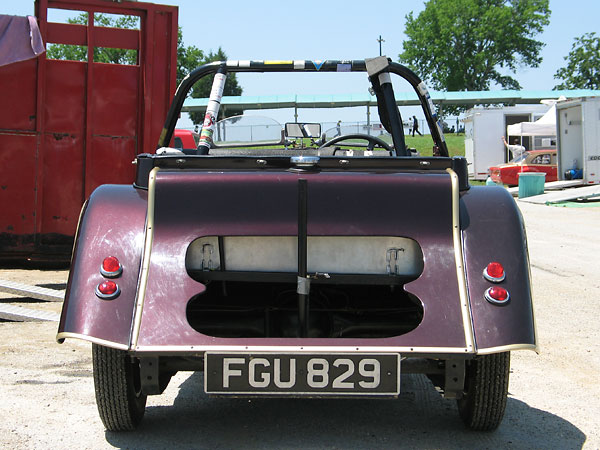
�
Early 4-4 Morgan's were designed to carry two spare tires upright. In a sprint race there's no need
�
to carry that dead weight, so they're shown removed here. The factory prepared a Morgan 4-4 for
�
Miss Prudence Fawcett to drive in the 1938 LeMans 24 hour race. Her car carried its spare tires
�
to the race mounted flat against a sloping rear panel. It only carried one spare wheel in the race.
�
�
All photos shown here are from June 2009, when BritishRaceCar.com viewed the car at The Heacock Classic Gold Cup at �
Virginia International Raceway. All photos by Curtis Jacobson for BritishRaceCar.com, copyright 2009. �
All rights reserved.
�
| If you liked this article, you'll probably also enjoy these: | �|||||
 | �
Dan Leonard '49 MG TC Special | �
 | �
Harry Gaunt '56 Morgan Plus 4 | �
 | �
Paul Bova '59 Turner Mk1 | �
| You're invited to discuss anything you've seen here on The British Racecar Motorsports Forum! | �|||||
�
Notice: all the articles and almost all the photos on BritishRacecar.com are by Curtis Jacobson.
�
(Photos that aren't by Curtis are explicitly credited.) Reproduction without prior written permission is prohibited.
�
Contact us to purchase images or reproduction permission. Higher resolution images are optionally available.
�

 �
�